In 2025, AI agent builder platforms are no longer niche tools — they are becoming central to how businesses scale intelligent automation. For innovation-minded executives, reliability-focused architects, and user-centric product teams alike, these platforms reduce friction, accelerate iteration, and lower operational risk.
Traditionally, building autonomous agents demanded extensive engineering, infrastructure, and orchestration. Today, advances in AI development—particularly visual and no-code tools—allow teams to define logic flows, map data connectors, and deploy agents with minimal coding effort. Tools like Google Opal, OpenAI AgentKit, LangFlow, and newer entrants such as Flowise are enabling this shift in how AI is built.
This blog explores what AI agents are and why they matter, outlines key criteria for selecting the best AI agent builders in 2025, and provides in-depth comparisons, practical use cases, and best practices for deployment and governance.
What Are AI Agent Builders
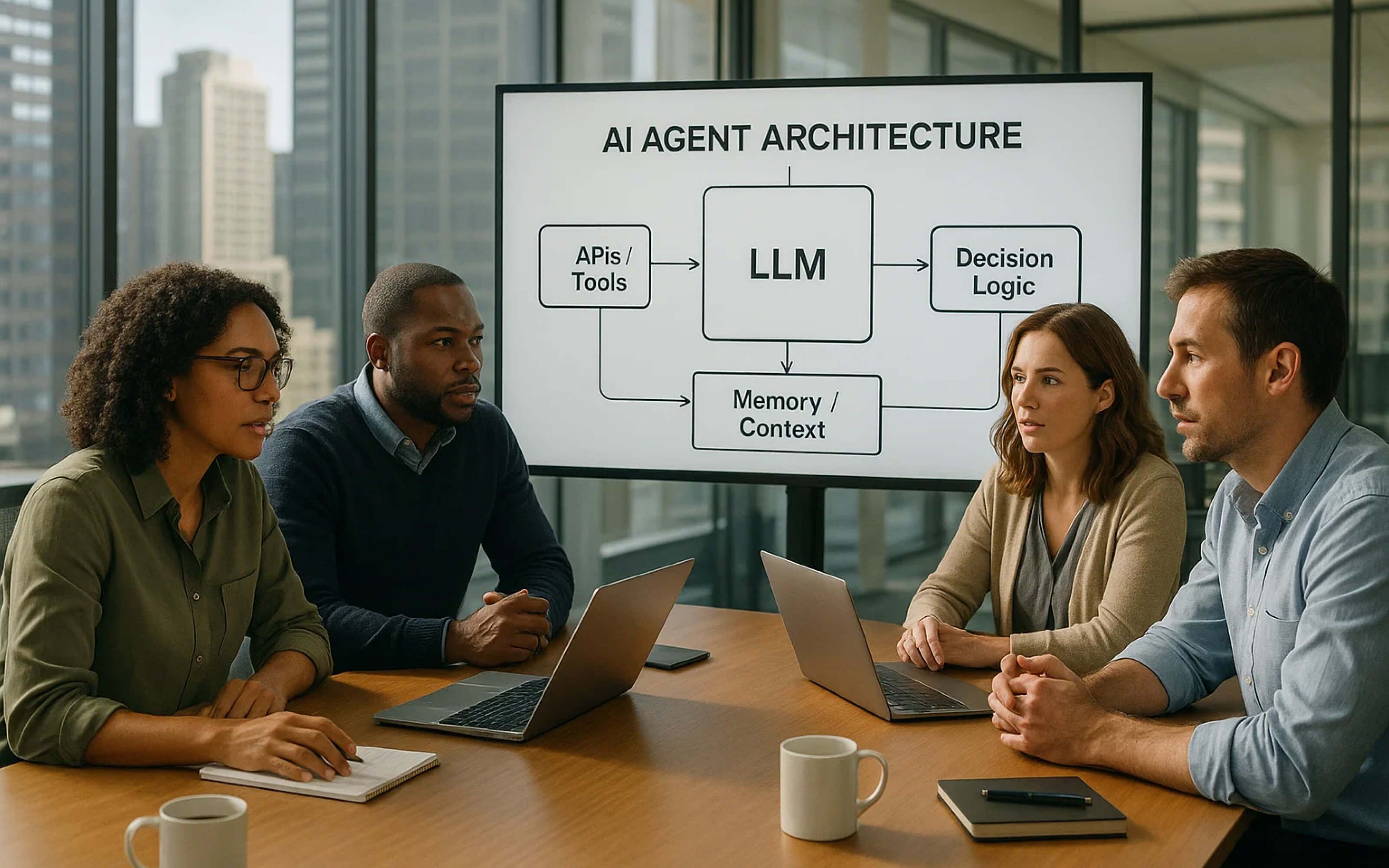
AI agent builders are platforms or tools that enable users to create, deploy, and manage AI agents without building them entirely from scratch. They provide visual interfaces, no-code workflows, and pre-built components that simplify designing intelligent agents capable of performing tasks autonomously.
These builders often include features like drag-and-drop logic flows, connectors to external systems, model integration, and deployment options. Modern AI agent builders accelerate AI development, reduce engineering complexity, and empower organizations to integrate intelligent automation into business processes quickly and effectively.
Today’s agents combine:
- LLMs (Large Language Models) for reasoning, synthesis, and conversational output
- Tool calls / APIs to external systems (databases, web search, SaaS)
- Memory/context modules to maintain state
- Decision logic/branching and sometimes, multi-agent orchestration, where agents call or hand off tasks among each other
Why They Matter Today
- LLMs have become more accessible, powerful, and cost-efficient, enabling broader adoption across teams and use cases.
- Visual interfaces and no-code abstractions—from conversational prompts to drag-and-drop flows—minimize reliance on specialized developers.
- Governance, observability, and version control are increasingly integrated, making AI solutions safer, auditable, and production-ready.
- Businesses demand scalable, modular AI systems that can evolve with workflows, rather than relying on rigid, monolithic models.
As a result, visual AI platforms and no-code AI builders are no longer limited to experimentation. They have become essential tools in enterprise AI strategy, powering both innovation and operational efficiency.
Key Criteria for Choosing the Best AI Agent Builders in 2025

Selecting the right AI agent platform requires more than just evaluating features—it’s about aligning capabilities with business needs, technical resources, and scalability goals. Top platforms empower teams to rapidly prototype, deploy, and optimize intelligent agents while maintaining governance, security, and cost efficiency.
The evaluation should cover usability, integration options, extensibility, data handling, compliance, and performance, ensuring that the platform supports both experimentation and production-ready deployment.
1. Ease of Use & Visual Design
Platforms should make it simple to convert logic and ideas into working flows. This includes:
- Natural language → flow: Describe processes conversationally and let the system generate visual workflows automatically.
- Drag-and-drop nodes: Easily build, inspect, and adjust workflows with clear branching logic.
- Versioning & testing: Track changes, roll back if needed, and experiment safely with A/B tests.
2. Integration & Extensibility
Your AI agents must work within your existing ecosystem:
- Connectors: Seamless integration with CRMs, databases, APIs, and SaaS tools.
- Custom code blocks: Even no-code platforms should allow developers to add snippets for complex logic.
- Model flexibility: Ability to switch LLM providers or use private models for specialized tasks.
- Deployment options: Hosted, hybrid, or self-hosted deployments, depending on business needs.
3. Data Handling, Security & Compliance
AI agents often work with sensitive information, so robust protections are essential:
- Memory systems & vector stores: Efficient retrieval of previous interactions and external knowledge.
- Evaluation pipelines: Track errors, hallucinations, and optimize prompts.
- Access control & audit logs: Ensure proper governance and traceability.
- Encryption & regulatory compliance: GDPR, HIPAA, and other standards for data safety.
4. Performance, Cost Models & Deployment Flexibility
Practical factors can determine the success of your deployment:
- Autoscaling & concurrency management: Handle multiple users without slowdowns.
- Latency & cold-start optimization: Reduce delays for better user experience.
- Transparent pricing: Understand costs per usage, compute, or tiered plans.
- Private hosting options: Critical for highly regulated or data-sensitive environments.
In-Depth Platform Comparison: Opal, AgentKit, & LangFlow
The AI development landscape is evolving rapidly, with new platforms emerging to simplify the creation of agents and workflows. Tools like Google Opal, OpenAI AgentKit, and LangFlow are redefining how developers, enterprises, and citizen creators approach AI application design. Each platform offers distinct capabilities—from visual building to orchestration and AI lifecycle management. Here’s a closer look at how they compare in functionality, flexibility, and real-world application.
1. Google Opal — Conversational + Visual AI App Builder
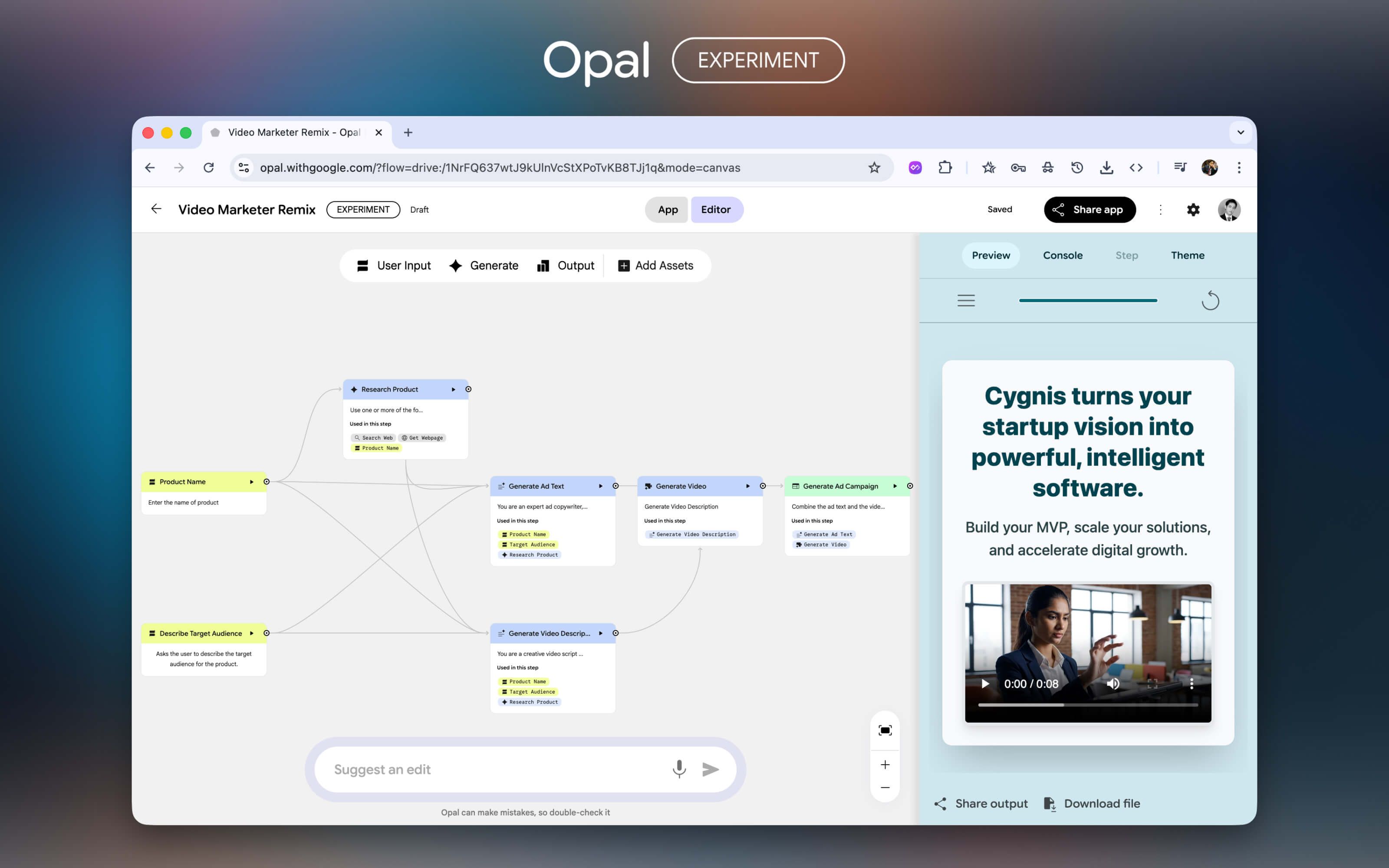
Google’s Opal is an experimental no-code platform that combines natural language understanding with visual workflow creation. It allows users to describe an idea or process in plain English, which Opal then translates into a functional visual application. This conversational approach lowers the barrier for non-technical users to create AI-powered tools.
Key Features
- Hybrid conversational + visual editing: Start by describing your app, then refine it using a drag-and-drop interface of nodes and connectors.
- Pre-built mini-app templates: Choose from templates for quizzes, document summarizers, content generators, and more to accelerate workflow creation.
- Multi-format input/output support: Accepts text, files, and URLs, and outputs structured responses, embeddings, or interactive elements.
- Instant sharing and deployment: Create shareable links to deploy mini-apps internally or publicly without extra hosting steps.
Strengths & Use Cases
- Rapid prototyping: Perfect for testing AI concepts or internal utilities without needing developer resources.
- Adoption by non-developers: Enables marketing, HR, and operations teams to create interactive AI tools easily.
- Seamless integration: Works naturally with the broader Google ecosystem (Docs, Sheets, Drive, Vertex AI).
Limitations
- Experimental phase: Limited enterprise readiness—no SLAs or advanced data governance yet.
- Restricted customization: Advanced developers may find API and UI flexibility lacking.
- Vendor lock-in: Heavy reliance on Google services can limit cross-platform portability.
Example Use
- Rapid prototyping: Perfect for testing AI concepts or internal utilities without needing developer resources.
- Adoption by non-developers: Enables marketing, HR, and operations teams to create interactive AI tools easily.
- Seamless integration: Works naturally with the broader Google ecosystem (Docs, Sheets, Drive, Vertex AI).
Limitations
- Experimental phase: Limited enterprise readiness—no SLAs or advanced data governance yet.
- Restricted customization: Advanced developers may find API and UI flexibility lacking.
- Vendor lock-in: Heavy reliance on Google services can limit cross-platform portability.
Example Use
A product marketing team used Opal to build an internal content ideation tool. Users entered a topic and target audience, and Opal generated structured blog outlines. The team then fine-tuned tone and flow using the visual editor, significantly speeding up content planning.
2. OpenAI AgentKit & Agent Builder — Full Agent Lifecycle Platform
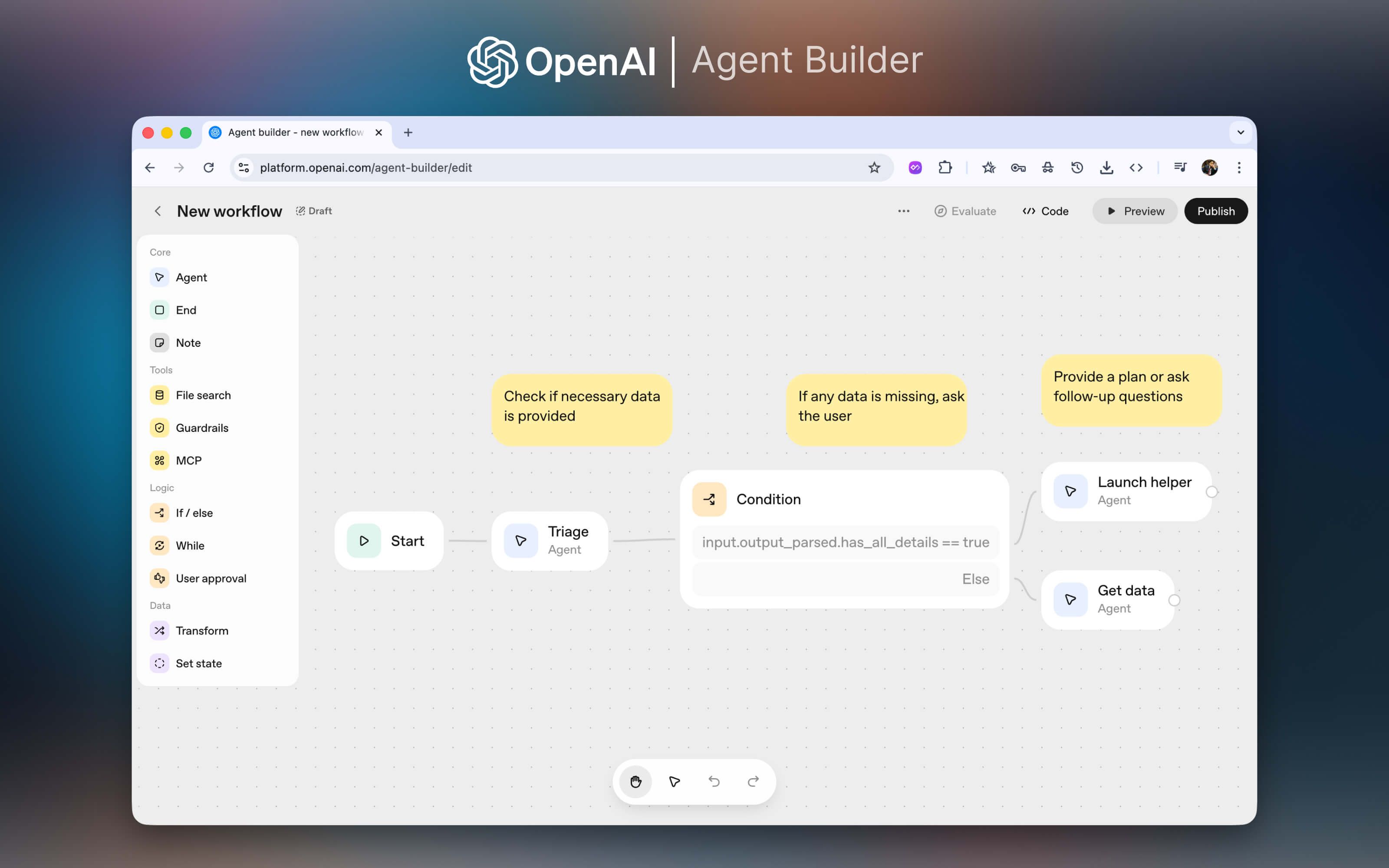
AgentKit is OpenAI’s end-to-end platform for building, deploying, and managing AI agents at production scale. It extends OpenAI’s APIs with robust features for orchestration, evaluation, UI integration, and versioning, enabling seamless lifecycle management from prototype to deployment. The platform provides governance, monitoring, and feedback mechanisms, ensuring reliability and compliance for enterprise-grade systems.
Key Features
- Visual agent canvas: Create complex workflows using branching logic, context windows, and memory handling.
- Connector registry: Integrate easily with third-party APIs, knowledge bases, and business systems.
- Built-in ChatKit UI components: Embed chat-style experiences directly into web or mobile applications.
- Feedback and evaluation system: Measure accuracy, latency, and user satisfaction to iteratively improve agent performance.
- Multi-agent orchestration: Coordinate multiple specialized agents (e.g., reasoning, data retrieval, summarization) in one pipeline.
- External model integration: Extend beyond GPT models by incorporating other APIs or private models.
Strengths & Use Cases
- Enterprise readiness: Offers governance, monitoring, and version control, ideal for organizations scaling AI solutions.
- Integrated lifecycle management: Supports development, deployment, and evaluation in one environment.
- Versatile applications: Suitable for use cases like AI-driven support bots, recommendation systems, or analytics assistants.
Limitations
- Ecosystem dependency: Tightly coupled with OpenAI’s APIs and pricing.
- Scalability costs: Resource-intensive for continuous high-volume interactions.
- Learning curve: Requires understanding of orchestration concepts for advanced use cases.
Example Use
An eCommerce company built a buyer assistant bot using AgentKit. It analyzed user preferences, compared product options, and generated personalized recommendations. The iterative testing loop in AgentKit reduced development time from several weeks to just a few hours.
3. LangFlow — Developer-First, Open-Source Visual Agent Framework
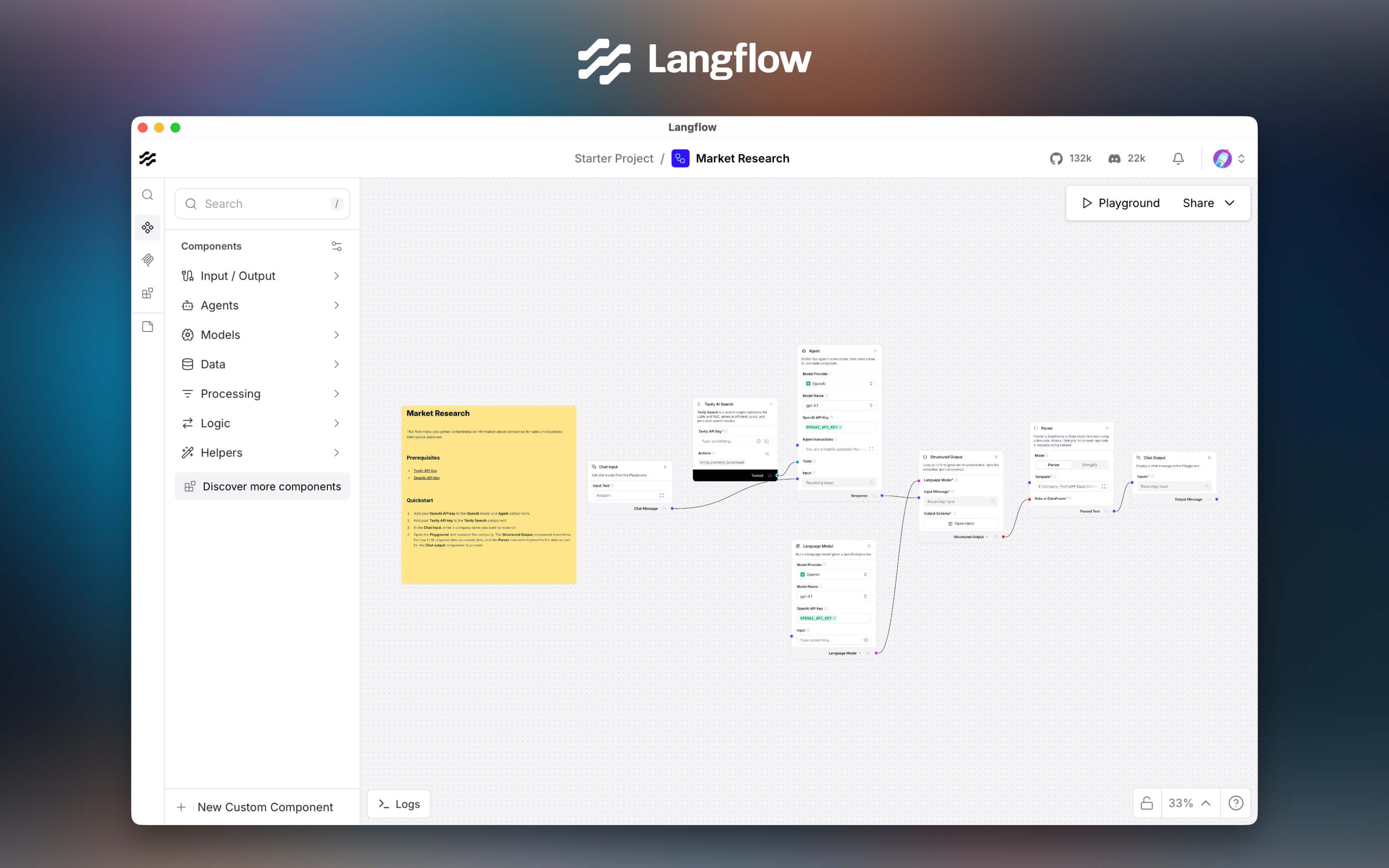
LangFlow, built on top of LangChain, provides a flow-based, open-source environment for designing and visualizing AI agent pipelines. It enables developers to connect LLMs, embeddings, and data sources through an intuitive visual interface. The platform emphasizes modularity and flexibility, allowing deep customization of workflows and logic. Developers can integrate custom Python functions or external APIs for advanced functionality. It’s ideal for AI researchers and technical teams seeking full control over agent behavior and data processing.
Key Features
- Node-based flow design: Drag and connect nodes representing LLMs, embeddings, retrieval chains, and memory components.
- Support for multiple AI stacks: Works with OpenAI, Anthropic, Hugging Face, or custom fine-tuned models.
- Custom code integration: Add custom Python functions for advanced logic, data processing, or API calls.
- Flexible deployment options: Export projects as APIs, microservices, or scripts for production use.
- Open-source foundation: Backed by a strong developer community with active plugin contributions.
Strengths & Use Cases
- Customizability: Ideal for teams that want to fine-tune prompts, retrieval strategies, and reasoning flows.
- Self-hosting control: Reduces dependency on external SaaS platforms, improving cost management and data privacy.
- Research and experimentation: Frequently used by AI labs to prototype retrieval-augmented generation (RAG) pipelines and reasoning chains.
Limitations
- Requires technical expertise: Non-developers may find the setup and customization process challenging.
- Maintenance overhead: Teams must handle hosting, scaling, and updates themselves.
Example Use
A legal-tech startup built an AI-powered contract assistant using LangFlow. The system allowed users to upload contracts, vectorize them for semantic search, and answer queries like “highlight risk clauses.” Developers fine-tuned retrieval logic and fallback reasoning directly in the visual editor for accuracy and reliability.
Learn more: Agentic AI: The Future of Autonomous Intelligence in Business
Flowise, N8N & Other Emerging Tools
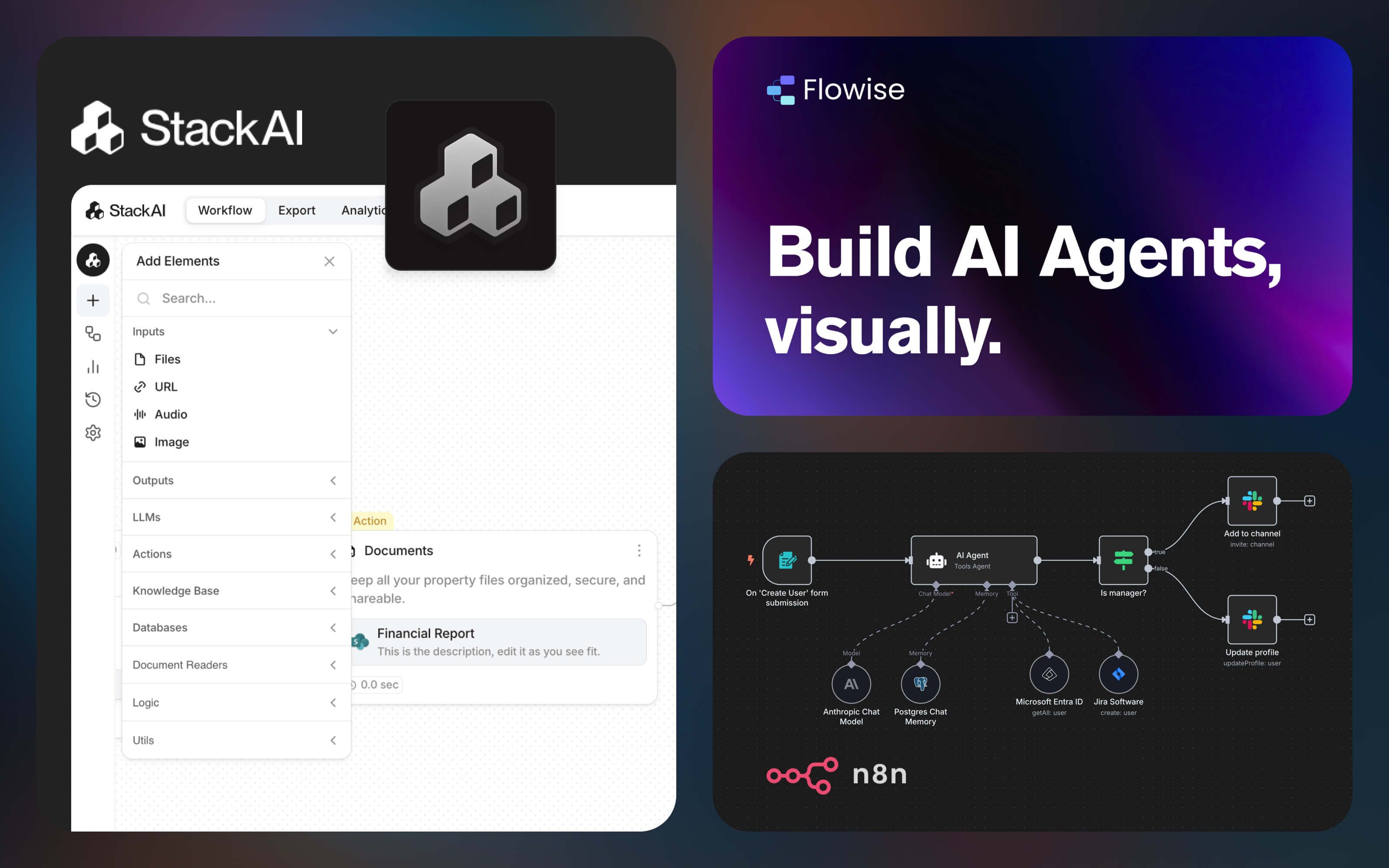
A new wave of tools like Flowise, N8N, and StackAI is redefining how teams integrate automation with intelligence. These platforms make it easier to combine AI-driven reasoning with workflow automation, enabling faster experimentation and smarter process design.
1. Flowise — Visual RAG & Agent Workbench
Flowise is an open-source, visual tool designed for building Retrieval-Augmented Generation (RAG) pipelines and lightweight AI agents. It lets users visually connect LLMs, data sources, and logic nodes to create custom chatbots or assistants using their own data. Ideal for quick prototyping, it offers flexibility for developers to test ideas before full-scale deployment. Flowise supports local or cloud deployment, making it a great starting point for data-centric AI experiments.
2. N8N — Automation Meets AI
N8N is a powerful workflow automation platform that now integrates AI functionalities through dedicated nodes. It enables teams to embed LLM-driven decision-making and text generation directly into automated workflows. Users can, for instance, create customer support flows where AI summarizes tickets or drafts responses. With its low-code visual interface, N8N bridges automation and intelligence, allowing both developers and non-technical users to streamline repetitive business tasks.
3. StackAI — Enterprise-Grade Agent Builder
StackAI focuses on bringing AI agent development to the enterprise level, combining scalability with compliance and governance features. It provides pre-built connectors for integrating with CRMs, databases, and analytics tools, along with deployment and monitoring dashboards. Teams can build secure, production-ready AI agents with built-in access controls and performance tracking. Designed for larger organizations, StackAI excels in governed agent orchestration and multi-environment deployment.
Practical Use Cases & Real Deployments

Exploring use cases and applications helps illustrate the impact of AI agent builders in action. These practical use cases show how organizations are leveraging platforms like Opal, AgentKit, and LangFlow to automate workflows, enhance decision-making, and drive efficiency.
Automating Customer Engagement & Support
A SaaS company leveraged LangFlow to deploy an intelligent ticket triage agent that analyzed customer queries, retrieved relevant knowledge base articles, and drafted context-aware responses. Ambiguous cases were automatically escalated to human agents, reducing low-tier support tickets by over 50% and improving response times.
Rapid Prototyping for AI-Powered Features
Product teams are using AgentKit and Google Opal to prototype conversational flows and AI-driven user experiences before full-scale engineering. These platforms enable teams to test logic, UI interactions, and content generation early in the design phase, significantly shortening feedback cycles and ensuring alignment with user needs.
Automating Internal Workflows & Analytics
Organizations rely on Opal and Flowise to streamline everyday business operations such as generating reports, summarizing weekly metrics, and sending automated alerts. By handling repetitive tasks autonomously, these tools free teams to focus on strategic analysis and decision-making, enhancing overall productivity.
Multi-Agent Systems for Complex Operations
Enterprises are adopting multi-agent architectures to manage interconnected processes—such as lead generation, research, or data summarization. Using AgentKit, teams can orchestrate multiple specialized agents that collaborate seamlessly, creating intelligent ecosystems capable of handling complex workflows from start to finish.
How to Choose, Deploy & Govern — Framework & Best Practices
The growing ecosystem of AI agent platforms demands a structured approach to selection, deployment, and governance. Choosing the right tool depends on your team’s technical maturity, compliance needs, and integration goals. The following framework outlines key evaluation criteria and best practices to ensure your AI systems are reliable, scalable, and secure.
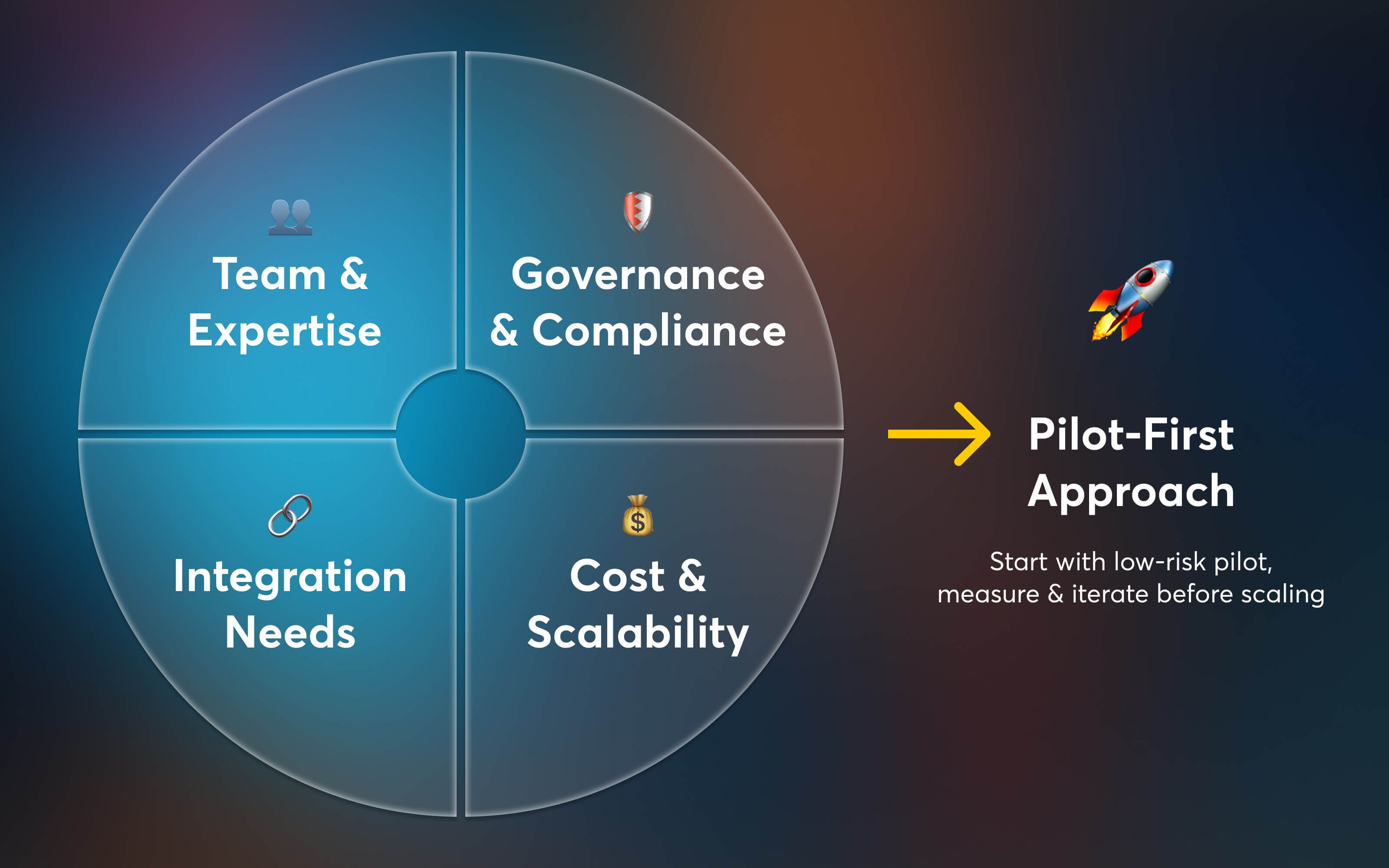
Evaluation Checklist
Team & Expertise
- If your team includes engineers, consider open or developer-first platforms for greater flexibility.
- If business users or non-technical teams are involved, choose visual or low-code tools for easier adoption.
Governance & Compliance
- Clearly define roles and responsibilities for building, testing, and deploying agents.
- Implement audit logs, approval workflows, and fallback controls to maintain accountability and reliability.
Integration Needs
- Review your critical systems (CRM, ERP, databases, APIs) and ensure the chosen platform supports seamless integration.
Cost & Scalability
- Estimate usage patterns and test potential costs related to API calls and compute usage.
- For self-hosted setups, include infrastructure and ongoing maintenance in your budget.
Pilot-First Approach
- Begin with a low-risk pilot project such as an internal assistant, report generator, or FAQ bot.
- Track performance, accuracy, and user satisfaction, then iterate based on feedback before scaling.
Deployment & Operational Best Practices
- Maintain separate environments for development, staging, and production.
- Version-control all prompts, flows, and logic for transparency and rollback options.
- Set up monitoring and observability to track latency, error rates, and hallucination patterns.
- Always include human-in-the-loop mechanisms for escalation and quality assurance.
- Enforce role-based access controls to safeguard data and manage permissions.
- Conduct regular audits and evaluations to ensure continuous agent improvement and compliance.
The Future of Agentic AI & Trends to Watch
As AI ecosystems advance, Agentic AI is evolving from experimental tools to core infrastructure for digital operations. Several trends are shaping the next phase of this evolution:
- AutoAgent / Zero-Code Agent Generation: Advancements in automation are enabling the creation of complete AI agents from simple natural language prompts — reducing the need for manual configuration.
- Hybrid Host-Managed Models: Platforms are beginning to blend managed orchestration with private data hosting, offering both convenience and data sovereignty.
- Edge and On-Device Agents: Designed for low-latency and offline performance, these agents bring intelligence closer to the user, improving privacy and responsiveness.
- Agent Marketplaces and Templates: The rise of pre-built, shareable blueprints allows faster customization and deployment across industries.
- Multimodal Agents: Next-generation systems will reason across text, images, video, and sensor data, enabling richer, context-aware interactions.
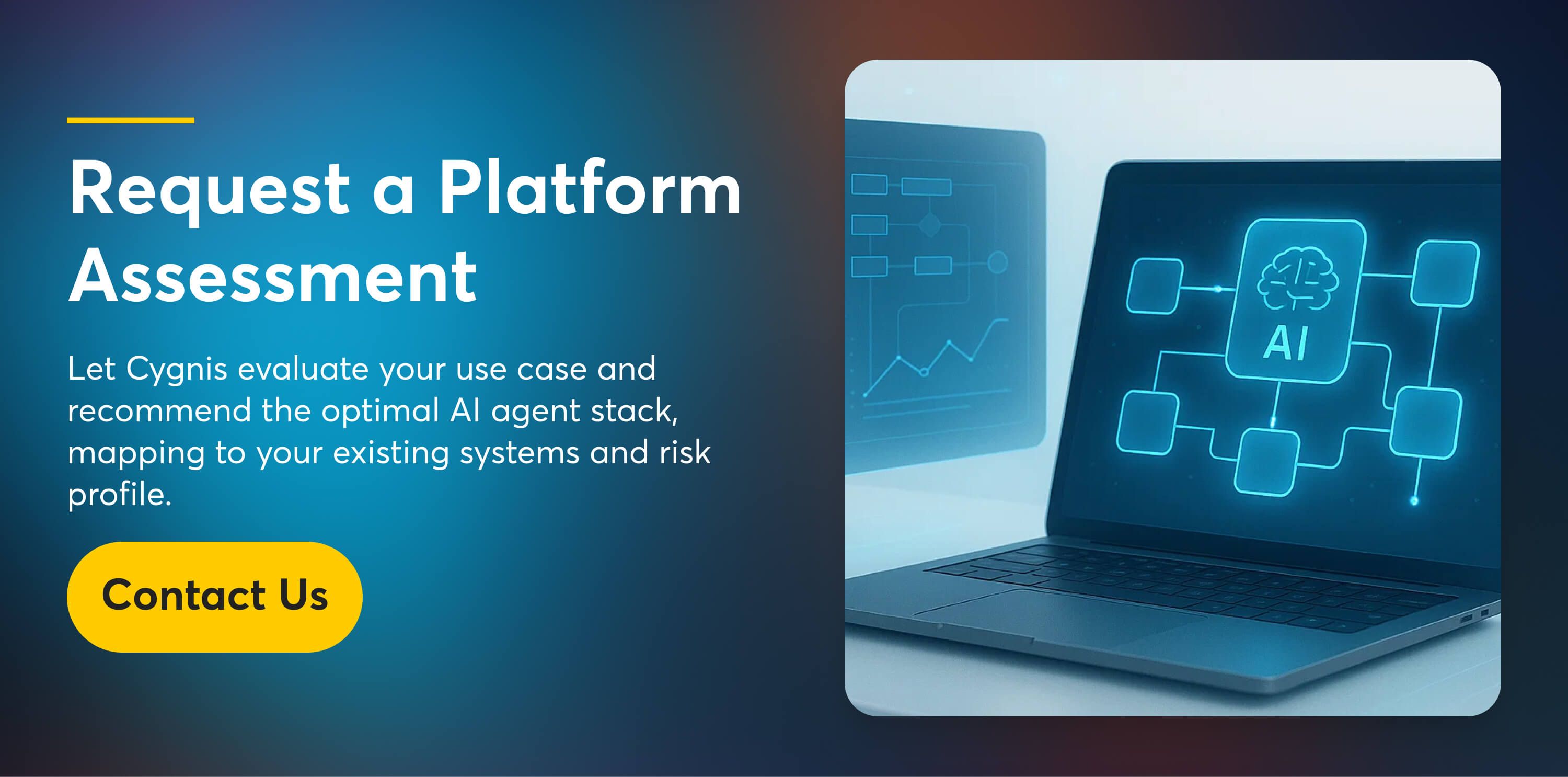
Conclusion:
AI agent builders are becoming the foundational platforms for innovation, efficiency, and scalability. These platforms empower both technical and non-technical users to bring automation and reasoning capabilities into everyday workflows. To sum up:
- Use Opal for quick prototypes and democratized access, ideal for non-technical teams and rapid experimentation.
- Use AgentKit for enterprise orchestration, versioning, and governance, perfect for production-grade deployments and multi-agent coordination.
- Use LangFlow for deep flexibility and custom logic, suited for developers and AI researchers building complex, tailored pipelines.
Each platform serves a unique purpose, from rapid prototyping to large-scale deployment. Choosing the right tool depends on your team’s expertise, infrastructure, and project goals. Ultimately, these builders mark a shift toward accessible, scalable, and governed AI — turning intelligent automation into a practical advantage for organizations ready to embrace the future.










